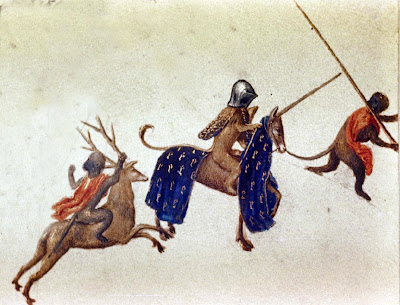OK, folks. It has been pointed out several times that this blog has become unduly concerned–perhaps even obsessed–with monkeys. That’s a fair cop.* But bear with me for just a little while longer here, as I take you on a tour of the margins of the “Hours of Englebert of Nassau,” a Dominican Book of Hours produced in Flemish lands near the end of the fifteenth century. Trust me, it’s worth the trip. This marginal image is a bit later than most of the monkeys you’ve seen so far (who live primarily in the ornamental borders of late thirteenth to mid fourteenth century gothic manuscripts), and is roughly contemporary with Thomas Malory’s Morte Darthur.** The artist responsible is today called the “Master of Mary of Burgundy,” after a commission he undertook for said Duchess of Burgundy. The difference in artistic sensibility is marked:

[This and all the other images today should expand when you click them.]
As frequent readers of Got Medieval already know, the medieval unicorn can only be tamed by a maiden, but can be ridden by a monkey. The Master of Mary of Burgundy combines these two facts to tell a little story in serial installments in the margins of this manuscript. Here, we find the maiden, having tamed the unicorn, preparing it to be ridden by a knight, assisted by the knight’s clever monkey squire. Just what sort of knight has a monkey squire?
Why, a monkey knight, of course:

This is actually the first image in the sequence, when the monkey receives his arms and armor from our mysterious Lady in Red.*** She then prepares his horse for him, as above. The next time we spy the monkey knight, he is riding toward adventure with his squire and another attendant, monkeys all:

What glorious adventure do they ride on to? The artist builds suspense. Several pages pass, until we spy another monkey, this one riding a boar, blowing a trumpet adorned with the monkey-knight’s arms:

If this were a comic book, I would call the final image in the sequence a “splash page.” It covers an entire leaf, on which we find that the monkey was riding on to a battle against some wildmen:

His monkey trumpeter appears to have left the battle, replaced now by a fox riding on a dog. And possibly, the wildman on the left has traitorously joined with the monkey’s animal forces.
Two final points of interest. The first is the elaborate linework forest scene in the background. It’s unlike anything I’ve ever seen elsewhere. Here’s the full page, on which you can see the trees and the birds that nest in them.

And finally, I may be seeing things, but I’m pretty sure that someone-possibly our master–has signed his name in the middle of the piece. I can’t quite make out the letters, though:
Extra credit to anyone who can put these images into a comic book-style series of panels and add narration and dialogue. I’ll post any submissions here.
—
*But society’s to blame.
**In other words, the printing press has been around for a generation at this point, though it has only recently arrived in England.
***This knight is occasionally identified as a lion, but I think that’s a mistaken impression created by the way the artist draws the knight’s tabard a bit later.
